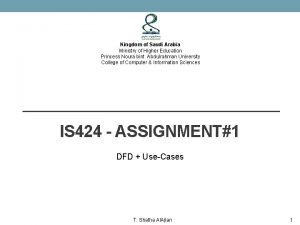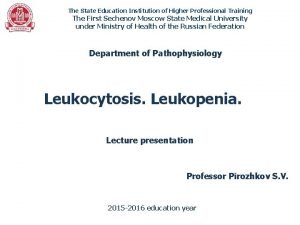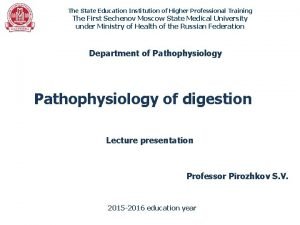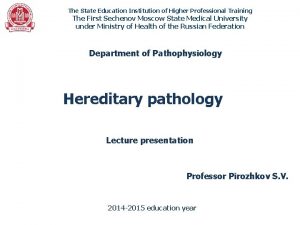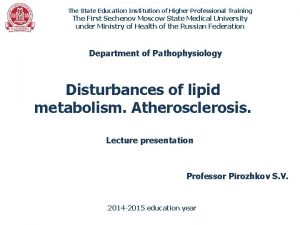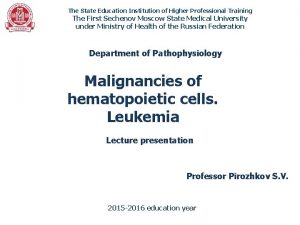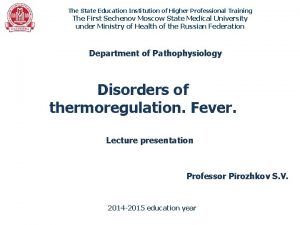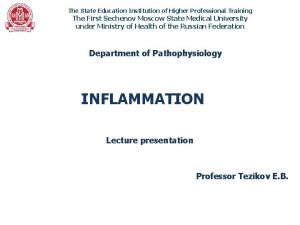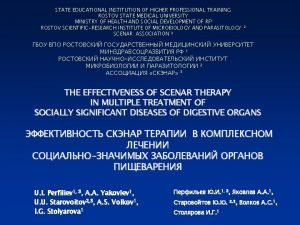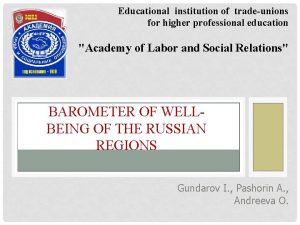The State Education Institution of Higher Professional Training
















- Slides: 16

The State Education Institution of Higher Professional Training The First Sechenov Moscow State Medical University under Ministry of Health of the Russian Federation Department of Pathophysiology Malignancies of hematopoietic cells. Leukemia Lecture presentation Professor Pirozhkov S. V. 2015 -2016 education year

Causes of hematopoietic cell malignancies ■ Inherited genetic factors - Fanconi anemia - ataxia-telengiectasia - Down syndrome ■ Chemical agents - benzene components of cigarette smoke petroleum products herbicides, pesticides ■ Viruses - Human T-lymphocyte leukemia virus I (HTLV-1) - Epstein-Barr virus - Human herpesvirus 8 ■ Physical factors - ionizing radiation ■ Iatrogenic factors - radiotherapy - chemotherapy

Classification of the hematopoietic cell malignancies I. Lymphoid neoplasms ● Lymphoid leukemias (originate in the bone marrow) ● Lymphomas (reside predominantly in lymphoid tissue) II. Myeloid neoplasms (arise in hematopoietic stem cells that give rise to cells of the myeloid lineage)

GENERAL CHARACTERISTICS OF LEUKEMIA ● Atypia of neoplastic blood cells ● Coexistence of two lines of hematopoietic cells of the same type: normal and transformed ● Impairment of differentiation of tumor cell line leading to the emergence of immature cells in the peripheral blood ● Crowding out of normal population of cells by tumor cells ● Leukemic picture of the peripheral blood

LEUKEMIC PERIPHERAL BLOOD PICTURE ● Leukocytosis (typical) ● Increase in young cells count, emergence of immature forms including blast cells (shift to the left) ● “Hiatus leukaemicus” (in case of acute myeloid leukemia) ● Eosinophillic-basophillic association (in case of chronic myeloid leukemia) ● Anemia ● Thrombocytopenia

TYPES OF LEUKEMIC PERIPHERAL BLOOD PICTURE BASED ON LEUKOCYTE COUNTS AND THE PRESENCE OF BLAST CELLS 1. Leukemic leukemia – leukocyte counts exceed 50, 000 or 80, 000 cells/μl; blast cells are abundant. 2. Subleukemic leukemia – leukocyte counts are below 50, 000 cells/μl; blast cells are abundant. 3. Leukopenic leukemia - leukocyte counts are below the normal value; blast cells are present. 4. Aleukemic leukemia – normal picture of the peripheral blood; malignant cells can be found only in the bone marrow.

MECHANISMS OF ANEMIA IN LEUKEMIA ● Crowding out of normal erythropoietic stem cells and their progenitors by tumor cells ● Competition between malignant and normal cells for substrates and vitamins, including B 12 and folic acid ● Production of antibodies or sensitized T-killers against normal erythrocytes (in chronic lymphocytic leukemia) ● Myelofibrosis with pancytopenia in late stages of chronic myeloproliferative diseases

GENERAL CHARACTERISTICS OF ACUTE LYMPHOBLASTIC LEUKEMIA AND LYMPHOMA (ALL) ● Neoplasm is composed of immature precursor B (pre-B) or T (pre-T) lymphocytes referred to as lymphoblasts ● The majority of ALL (~85%) are pre-B tumors that typically manifest as childhood acute leukemia ● The less common pre-T cell ALLs tend to present in adolescent males as lymphomas, often with thymic involvement ● The bone marrow and the peripheral blood contain > 20% lymphoblasts

PERIPHERAL BLOOD FINDINGS IN ACUTE LYMPHOBLASTIC LEUKEMIA ● At least 20% lymphoblasts in the peripheral blood; the phenotype of lymphoblasts in most common children precursor B-lymphoblastic leukemia: Td. T+ (terminal deoxynucleotidyl transferase), CD 19+, CD 22+ ● Anemia ● Neutropenia ● Thrombocytopenia ● The leukocyte count is occasionally very high (>100 • 109/L); often is slightly elevated, normal or decreased

GENERAL CHARACTERISTICS OF CHRONIC LYMPHOCYTIC LEUKEMIA AND LYMPHOMA (CLL) ● The most common – B-cell form presents with asymptomatic lymphocytosis in patients with a median age of 60 years ● The minimum lymphocytosis to make the diagnosis of CLL is 5 • 109/L ● The incidence is over 10 per 100, 000 per year for persons over 70 but less than 1/100, 000 for those under 50 ● More common in males and in whites ● The peripheral blood contains fragile lymphocytes which are frequently disrupted in the process of making the smear, producing the so–called smudge cells (Klein. Gumprecht bodies)

PERIPHERAL BLOOD FINDINGS IN CHRONIC LYMPHOCYTIC LEUKEMIA ● Leukocytosis due to lymphocytes that exceed 5 • 109/L ● Moderate anemia ● The presence of smudge cells in the blood smear

GENERAL CHARACTERISTICS OF MYELOID NEOPLASMS ● Originate from a progenitor cell that normally gives rise to terminally differentiated cells of the myeloid series (erythrocytes, granulocytes, monocytes, and platelets) ● The disease almost always involves bone marrow and to a lesser degree the secondary hematopoietic organs (spleen, liver, and lymph nodes)

PERIPHERAL BLOOD FINDINGS IN ACUTE MYELOGENOUS LEUKEMIA ● At least 20% myeloid blasts in blood (and/or in bone marrow) ● Anemia ● “Hiatus leukemicus” (presence of myeloblasts and promyelocytes, but absence of myelocytes and metamyelocytes) ● Thrombocytopenia ● The number of leukemic cells in the peripheral blood is highly variable, sometimes being more 100 • 109/L, but being under 10 • 109/L in about 50% of the patients ● Occasionally the peripheral blood smear may not contain any blasts (aleukemic leukemia)

GENERAL CHARACTERISTICS OF CHRONIC MYELOGENOUS LEUKEMIA (CML) ● Refers to chronic myeloproliferative disorders ● CML affects primarily adults, peaking in incidence between ages 30 and 40 years ● The diagnosis of CML is established by identifying a clonal expansion of hematopoietic stem cell possessing a reciprocal translocation between chromosomes 9 and 22 ● The disease is characterized by inevitable transition from a chronic phase to an accelerated phase and on to blast crisis

FORMATION OF CHIMERIC ONCOGENE IN CHRONIC MYELOGENOUS LEUKEMIA 9 NORMAL CHROMOSOMES 9 22 22 bcr locus abl oncogene abl-bcr hybrid gene Tyrosine kinase

● ● ● PERIPHERAL BLOOD FINDINGS IN POLYCYTHEMIA VERA The erythrocytes number 6 to 12· 109/L, the Hb is 180 to 240 g/L Polychromatic cells and normoblasts may be found Thrombocytosis (in ~2/3 of patients), often > 1000· 109/L; functional platelet abnormalities (e. g. decreased aggregation in response to epinephrine) ● Moderate neutrophilia in the range of 10 to 30· 109/L; immature granulocytes in ~50% of cases ● Basophils are often absolutely increased
 Formal institution and informal institution
Formal institution and informal institution Department of higher education and training
Department of higher education and training Training for higher education professionals
Training for higher education professionals Federal state autonomous educational institution
Federal state autonomous educational institution Hidden curriculum in education
Hidden curriculum in education Web analytics in higher education
Web analytics in higher education Capacity building in the field of higher education
Capacity building in the field of higher education Importance of faculty in higher education
Importance of faculty in higher education Ri board of governors
Ri board of governors Ppc for higher education
Ppc for higher education Ministry of higher education afghanistan
Ministry of higher education afghanistan Massachusetts higher education consortium
Massachusetts higher education consortium Kurdistan
Kurdistan Ministry of higher education kurdistan
Ministry of higher education kurdistan Krg ministry of higher education
Krg ministry of higher education Ministry of higher education saudi arabia
Ministry of higher education saudi arabia Internationalization of higher education in the philippines
Internationalization of higher education in the philippines















